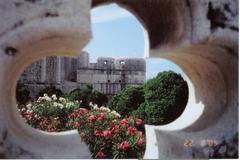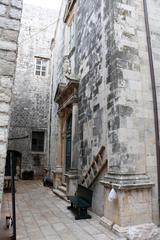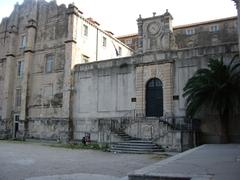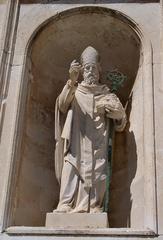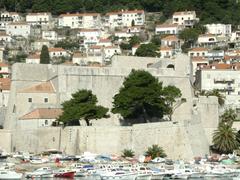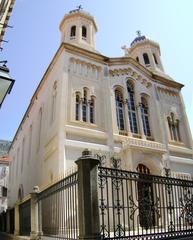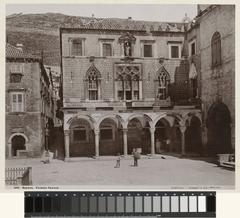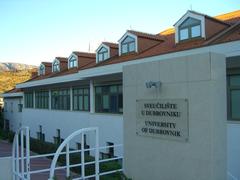
Stadion Lapad Visiting Hours, Tickets, and Guide to Dubrovnik Historical Sites
Date: 04/07/2025
Introduction: Stadion Lapad’s Role in Dubrovnik
Stadion Lapad, situated in Dubrovnik’s lively Lapad district, is a key emblem of the city’s modern cultural pulse and community identity. Unlike the globally celebrated medieval Old Town, Stadion Lapad reflects over a century of local sporting tradition and social life, serving as the home of NK GOŠK Dubrovnik since 1919. It stands as a vibrant community hub, providing a snapshot of everyday Dubrovnik and offering visitors a unique opportunity to experience the city beyond its historic walls.
This guide details visiting hours, ticketing, accessibility, and facilities at Stadion Lapad, while also exploring its architectural character, cultural resonance, and future redevelopment plans. It further highlights nearby attractions—Lapad’s beaches, promenades, and Velika Petka hill—allowing travelers to enrich their Dubrovnik itinerary with both historical and contemporary experiences. For the latest updates, visitors should refer to official sources such as the NK GOŠK Dubrovnik website and local tourism offices (Heritage Hotels of Europe, StadiumDB.com, Dubrovacki Slobodna Dalmacija).
Stadion Lapad: History and Urban Context
Historical Evolution
Stadion Lapad emerged during the urban expansion of Dubrovnik in the 20th century, reflecting the city’s embrace of structured recreational life. Since its establishment, the stadium has been integral to NK GOŠK Dubrovnik’s identity (est. 1919), hosting countless regional matches and community events. Its legacy is interwoven with local pride and the evolution of Lapad from a tranquil suburb to a dynamic urban neighborhood (Heritage Hotels of Europe).
Architecture and Location
The stadium’s mid-20th-century design features a grass pitch, a main grandstand with bolted bucket seats, and standard amenities for players and officials. Its functional style is characteristic of the era’s public infrastructure, with an emphasis on utility over ornamentation. Stadion Lapad is strategically located near Lapad Bay and the green slopes of Velika Petka hill, integrating natural beauty with urban vibrancy (Mapcarta). Recent upgrades—improved lighting, pavements, and benches—have enhanced accessibility and visitor comfort (Dubrovacki Slobodna Dalmacija).
Visiting Stadion Lapad: Hours, Tickets, and Access
- Opening Hours: The stadium is open to visitors primarily during scheduled football matches and community events. Gates generally open 30–60 minutes before kickoff. Outside of event times, public access is limited; check the NK GOŠK Dubrovnik website or local tourism resources for up-to-date schedules.
- Tickets: Match tickets are available at the stadium entrance on event days, typically priced around €5. There are no regular online or advance ticket sales.
- Guided Tours: No standard guided tours are offered, but special arrangements may be made through local tourism offices or during community events.
- Accessibility: Stadion Lapad’s terraced design poses challenges for visitors with limited mobility, as there are no lifts or ramps. Recent improvements have slightly enhanced access, but advance inquiry is advised for those with specific needs.
Facilities, Capacity, and Visitor Experience
- Capacity: The stadium accommodates approximately 3,000 spectators, with a main stand featuring bucket seats and the remainder as standing terraces.
- Restrooms and Refreshments: Basic restroom facilities are available. There are currently no permanent food and beverage outlets inside; visitors are advised to enjoy local cafes and bakeries before or after events.
- Atmosphere: The venue is known for its intimate, authentic football experience, fostering a close connection between fans and players. On match days, visitors encounter passionate local supporters and a family-friendly environment.
Cultural and Social Significance
Stadion Lapad is not just a sports venue; it is a living part of Dubrovnik’s community fabric. It hosts youth tournaments, charity events, and public festivals, supporting social inclusion and intergenerational engagement. The stadium represents Lapad’s shift toward a more dynamic urban identity while preserving traditions rooted in grassroots football (Heritage Hotels of Europe).
Redevelopment: Vision for the Future
Integrated Urban Complex
Plans are underway to transform Stadion Lapad into a state-of-the-art, multi-use facility. The proposed redevelopment, based on an international design competition and a public-private partnership model, envisions a complex with:
- Three underground parking levels (approx. 800 spaces)
- Two above-ground retail levels
- A new 5,000-seat stadium for sports and community events (StadiumDB.com)
Urban Greenery and Infrastructure
Adjacent urban renewal projects include the revitalization of King Tomislav Street, featuring the replacement of aging pines with resilient hybrid elms, new pedestrian pathways, and a modern irrigation system. These upgrades aim to create a welcoming and environmentally friendly approach to the stadium (The Dubrovnik Times).
Community Dialogue
Dubrovnik’s mayor has emphasized the importance of maintaining the stadium in its current location and engaging the public in the redevelopment process, balancing modernization with the district’s identity and accessibility (Južni.hr).
How to Get There
- Address: Kralja Tomislava bb, Lapad district, Dubrovnik
- Transport: Easily accessible by public bus from the Old Town (approx. 15 minutes) or on foot (approx. 45 minutes). Parking is currently limited but will expand with redevelopment.
- Nearby Attractions: Lapad Bay beaches, the scenic Lapad promenade, Velika Petka hill, and Cave Bar More are all within walking distance (dubrovnik-travel.net, dubrovniktourguide.com).
Nearby Attractions, Dining, and Accommodation
- Lapad Beaches: Uvala Lapad, Copacabana, and Cava Beach, each offering distinctive atmospheres, water sports, sunbathing, and bar options (dubrovnik-travel.net).
- Promenades and Parks: The Lapad promenade is lined with cafes, boutiques, and offers Adriatic sunset views. Petka Hill Park provides hiking and panoramic vistas.
- Dining: Enjoy local cuisine like black risotto, seafood, and “peka” at nearby restaurants. Accompany your meal with regional wines such as Plavac Mali and Pošip (dubrovniktourguide.com).
- Accommodation: Options range from luxury resorts to budget apartments in Lapad, often more affordable than Old Town hotels (dubrovnik-travel.net).
Visitor Tips
- Best Time to Visit: July is peak season—vibrant but crowded. Spring and early autumn offer pleasant weather with fewer visitors (northcoastcroatia.com).
- Dress Code: Casual attire is suitable for the stadium and beaches; modest dress is preferred in restaurants (lonelyplanet.com).
- Events: While primarily a sports venue, Stadion Lapad is close to festival sites during Dubrovnik’s summer cultural season.
Frequently Asked Questions (FAQ)
Q: What are Stadion Lapad’s visiting hours?
A: Open primarily during scheduled events, with gates opening 30–60 minutes before. Non-event visits require prior arrangement.
Q: How do I purchase tickets?
A: Tickets are sold at the stadium entrance on match days; advance purchase is not typically available.
Q: Is the stadium wheelchair accessible?
A: Accessibility is limited due to the stadium’s design; redevelopment will improve this. Contact the venue for specific accommodations.
Q: Are guided tours offered?
A: Not regularly, but may be arranged through tourism offices during special events.
Q: What else can I see nearby?
A: Lapad’s beaches, promenade, Petka Hill Park, and Dubrovnik’s Old Town are all easily accessible.
Plan Your Visit and Stay Connected
Stadion Lapad offers a refreshing alternative to Dubrovnik’s historic attractions, providing insight into the city’s contemporary spirit and local culture. For the latest information on matches, events, and redevelopment progress, consult the Sportski Objekti Dubrovnik website or the NK GOŠK Dubrovnik channels. Download the Audiala app for real-time updates and explore our related articles for more travel inspiration.
References
- Discover Stadion Lapad: A Historic and Cultural Landmark in Dubrovnik, 2025, Heritage Hotels of Europe (https://heritagehotelsofeurope.com/discovering-dubrovnik/)
- Stadion Lapad Redevelopment Plans and Visitor Information in Dubrovnik, 2025, StadiumDB.com (https://stadiumdb.com/designs/cro/gradski_stadion_lapad)
- Rasvjeta, novi pločnik i klupe kod ulaza na Lapadski stadion, 2025, Dubrovacki Slobodna Dalmacija (https://dubrovacki.slobodnadalmacija.hr/dubrovnik/zupanija/dubrovnik/rasvjeta-novi-plocnik-i-klupe-kod-ulaza-na-lapadski-stadion-630661)
- Out with the old, in with the new: revitalizing Dubrovnik’s urban greenery with resilient hybrid elms, 2025, The Dubrovnik Times (https://www.thedubrovniktimes.com/news/dubrovnik/item/17271-out-with-the-old-in-with-the-new-revitalizing-dubrovnik-s-urban-greenery-with-resilient-hybrid-elms)
- Gradonačelnik Dubrovnika: Novi stadion mora biti u Lapadu, 2025, Južni.hr (https://juzni.hr/gradonacelnik-dubrovnika-novi-stadion-mora-biti-u-lapadu.html)
- Stadion Lapad Visiting Hours, Tickets, and Facilities Guide, 2025, Sportski Objekti Dubrovnik (https://sportskiobjektidu.hr/objekti/)
- Additional references for local travel, beaches, and cuisine: dubrovnik-travel.net, dubrovniktourguide.com, northcoastcroatia.com, lonelyplanet.com, hr.wikipedia.org


